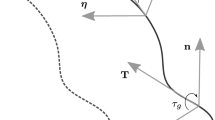Abstract
The aim of the paper is to show, using the one-dimensional problem as an example, what is to be expected and what should be pursued when studying the multidimensional case. The one-dimensional case has been chosen as a model, because here the problem admits an explicit solution permitting one to follow the phase transformation process.
Similar content being viewed by others
References
Zarubin, V.S. and Kuvykin, G.N., Matematicheskie modeli termomekhaniki (Mathematical Models of Thermomechanics), Moscow: Fizmatlit, 2002.
Christensen, R.M., Mechanics of Composite Materials, New York: Wiley, 1979.
Grinfeld, M.A., Metody mekhaniki sploshnykh sred v teorii fazovykh prevrashchenii (Methods of Continuum Mechanics in Phase Transition Theory), Moscow: Nauka, 1990.
Allaire, G., Shape Optimization by the Homogenization Method, New York: Springer-Verlag, 2002.
Müller, S., Variational Models for Microstructure and Phase Transitions, Leipzig: Max-Planck-Institut für Mathematik in den Naturwissenschaften, 1998.
Dacorogna, B., Direct Methods in the Calculus of Variations, Berlin: Springer-Verlag, 1989.
Osmolovskii, V.G., Existence of equilibria in a one-dimensional phase transition problem, Vestnik St. Petersburg. Univ. Ser. 1: Mat. Mekh. Astron., 2006, no. 3, pp. 54–65.
Osmolovskii, V.G., Stability of one-phase equilibrium states of a two-phase elastic medium with zero surface tension coefficient: One-dimensional case, J. Math. Sci., 2006, vol. 135, no. 6, pp. 3437–3456.
Osmolovskii, V.G., Exact solutions of the phase transition problem in a one-dimensional model case, Vestnik St. Petersburg. Univ. Math., 2007, vol. 40, no. 3, pp. 182–187.
Evans, L.C. and Gariepy, R.F., Measure Theory and Fine Propeties of Functions, London: CRC, 1992.
Butazzo, G., Giaquinta, M., and Hildebrandt, S., One-Dimensional Variation Problems: An Introduction, Oxford: Clarendon, 1998.
Gel’fand, I.M. and Fomin, S.V., Variatsionnoe ischislenie (Calculus of Variations), Moscow: Gos. Izd. Fiz. Mat. Lit., 1961.
Osmolovskii, V.G., One-dimensional phase transition problem of continuum mechanics with microinhomogeneities, J. Math. Sci., 2010, vol. 167, no. 3, pp. 394–405.
Osmolovskii, V.G., Quasistationary phase transition problem in two-phase media: One-dimensional case. The zero surface stress coefficient, J. Math. Sci., 2015, vol. 210, no. 5, pp. 664–676.
Osmolovskii, V.G., Matematicheskie voprosy teorii fazovykh perekhodov v mekhanike sploshnykh sred (Mathematical Problems of Phase Transition Theory in Continuum Mechanics), St. Petersburg Mathematical Society, Preprint 2014-04. http://www.mathsoc.spb.ru/preprint/2014/14-04.pdf
Author information
Authors and Affiliations
Corresponding author
Rights and permissions
About this article
Cite this article
Osmolovskii, V.G. Boundary Value Problems with Free Surfaces in the Theory of Phase Transitions. Diff Equat 53, 1734–1763 (2017). https://doi.org/10.1134/S0012266117130043
Published:
Issue Date:
DOI: https://doi.org/10.1134/S0012266117130043



